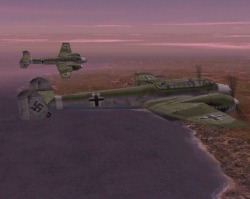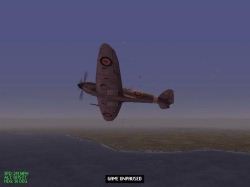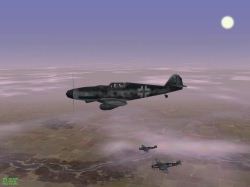| Strategy in EAW
by Microprose |
||||
|
"The Bf110 was simply too heavy to contend with either the Spitfire or the Hurricane. You had to be lucky to survive." "Our mission was to escort a bomber formation in an attack on Kenely, an airfield near London. Flying at about 6000 meters altitude, we reached the target without being attacked and were only then engaged by British fighters, which were primarily interested in the bombers and Bf110's. I was still right beside the bombers when a Spitfire immediately beneath me attacked a circling Bf110. It was simple for me to get behind the attacker with a short maneuver.  We then had a Bf110, a Spitfire and a Bf109 (myself) flying in a row. While the rear gunner fired at the Spitfire and the Spitfire in turn attempted to silence the rear gunner, I found it easy to put a long burst into the Spitfire, which immediately smoked and broke away…" -Jupp Buerschgens, 10 victories before this same Bf110 mistook him for another Spitfire and shot out his engine, resulting in six years of captivity in England. Lesson Learned: The Bf110, though successful in Poland and France, was severely outmatched in terms of maneuverability by British fighters. Independent operations in this aircraft are an invitation to disaster. When mixed formations of Bf109's and Bf110's are pressed by enemy fighter cover, the best tactic for Bf110's was to assume a defensive circle, where the nose of each aircraft covered the tail of the aircraft in front of it. This circle, though defensive rather than offensive in nature, can still be moved around the sky to complicate the tactical situation of enemy single seat fighters seeking to engage Bf109's in support. They cannot discount the presence of the Bf110's entirely because the latter can roll out of the circle at any given time to shift the odds of an existing engagement, even perhaps with a small measure of surprise to an unwary pilot.
"The Spitfires showed themselves wonderfully maneuverable. Their aerobatics display--looping and rolling, opening fire in a climbing roll--filled us with amazement. There was a lot of shooting, but not many hits." Lesson Learned: You can pilot the most maneuverable aircraft in the world but, without good deflection shooting skills to back up your flying prowess, you are still ineffective as a combat pilot. |
 Spitfire "The Gruppe flew over Dover, gaining quite a bit of altitude. Suddenly, I saw a squadron of English fighters climbing far beneath us. We had probably been reported, and the British were looking for us…I lead the Gruppe after them immediately. We were in a favorable position as we approached. Eight aircraft, Hurricanes, flew in front in flights of vees. Behind them was a cover flight. Its fourth aircraft was weaving--flying first left then right. The English still had not seen us. They now had the more favorable position, since they were higher, but we attacked. I flew toward the weaving aircraft. At 100 meters, I had it in front of me, and pressed the button. The fire of my cannon and machine guns literally blew the Hurricane apart. Pieces fell away smoking and burning. The second aircraft in the cover flight was now in my sights. I repeated the same maneuver. I opened fire and the Hurricane burst into flames.
Undisturbed, the others continued spiraling upward. They had no inkling that there were Messerschmitts on their tails. Now I was behind the third aircraft. A short burst, and this one likewise fell apart. Number three! The Englishmen flew onward; still they had noticed nothing. So I took on the fourth aircraft. This time, however, I approached too closely. When I pressed the button, the Englishman exploded, so near me that pieces hit my crate. It sprayed oil so thickly on the front and right side of my canopy that I could see nothing, and had to break off the battle, which had lasted two minutes."
 Lessons Learned: The tail end of a formation is always the most vulnerable to attack. Be mindful of this fact offensively and defensively, both to achieve surprise and avoid being surprised. Further, the British pilots in this engagement exhibited exceptionally poor situational awareness. A similar lack of observational discipline on your part in EAW will prove equally detrimental to your career. Finally, you should note two things: destroying an enemy at point blank range endangers your aircraft as well, and a lot can happen in air combat in a very short time span. Go to Page Three
|
|||
|
Copyright © 1997 - 2000 COMBATSIM.COM, INC. All Rights Reserved. Last Updated May 26th, 1999 |
||||
